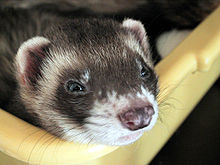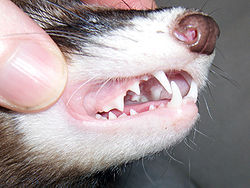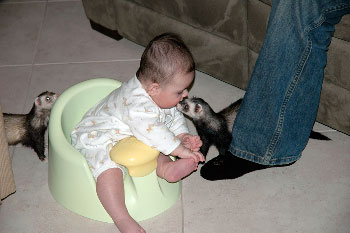
January 19, 2011


In the realm of animal folklore, the tales of ferrets eating the faces off of babies who have the smell of milk around them may not be as far-fetched as some may think.

A 4-month-old baby boy from Grain Valley, Missouri, was in critical condition after a family pet ferret ate seven of the infant’s fingers, and the boy’s parents are under investigation for neglect and failure to obtain a $100 license for the exotic pet, police chief Aaron Ambrose told CNN’s Michael Martinez.
Authorities are not releasing the names of the baby or his parents, Ambrose said.
The mother was awakened at 2:30 a.m. Monday, January 10th, 2011, to her baby’s crying, and she awakened her husband with screams upon discovering what happened, Ambrose said.
The dad killed the pet by hurling it across the house, Ambrose said.
The baby now has only two thumbs and a partial pinkie, the chief said. The ferret was about six months old, a police report said.
“It’s very unusual, there’s no doubt about it,” Ambrose said of the incident.
Ambrose said he believed the ferret was a young animal recently acquired by the family.
“We’re trying to figure out if this thing had a crate or a cage, or was it running around the house,” Ambrose said. “It jumped into the rocker thing that the baby was sleeping in and ate seven of its fingers.”
The parents said “they never heard the baby crying” until late into the ordeal, Ambrose said. “Who knows what’s going on there. These are all things we’re working on now — where they were sleeping and where the baby was in conjunction with them.”
Upon seeing the ferret, the father “just grabbed it and threw it,” Ambrose said. “It hit a dishwasher or cabinet or something like that.”
A necropsy is being performed on the ferret to examine its stomach contents and determine whether the animal had rabies, Ambrose said.
In the recent past, animal control officers responded to complaints about the family’s dogs, including a Rottweiler, Ambrose said.
“They have had other animal issues with dogs for licensing and things like that,” Ambrose said, adding that a dog license costs $10 or so in Grain Valley. “There was a concern back in the summer about barking dogs and…the way they were keeping the animals.”
In the wake of the most recent incident, ferret activists and rescuers from around the country have called Ambrose about the pet.
“We’ve had them calling from all sorts of states asking about the ferret,” Ambrose said. “Well, I guess if you collect dead ferrets, you can have one.”
Ambrose said parents should examine safety about pets.
“If you have a baby or children, if you have animals, I would assume you want to educate yourself on the animal,” Ambrose said. “Are they good around kids? Hopefully, people will take a general look at this and see what’s the lesson.”
The ferret is a domesticated mammal with the specific species name, Mustela putorius furo. Ferrets are sexually dimorphic predators with males being substantially larger than females.
Several varied small elongated carnivorous mammals belonging to the family Mustelidae (weasels) also have the word ferret in their common names, including an endangered species, the Black-footed Ferret. The ferret is a very close relative of the polecat, but it is as yet unclear whether it is a domesticated form of the European Polecat, the Steppe Polecat, or some hybrid of the two.
In common with most domestic animals, the original reason for ferrets’ being domesticated by human beings is uncertain, but it may have involved hunting. It was most likely domesticated from the European polecat (Mustela putorius), although it is also possible that ferrets are descendants of the Steppe polecat (Mustela eversmannii), or some hybridization thereof. Analysis of mitochondrial DNA suggests that ferrets were domesticated around 2,500 years ago, although what appear to be ferret remains have been dated to 1500 BC. It has been claimed that the ancient Egyptians were the first to domesticate ferrets, but as no mummified remains of a ferret have yet been found, or any hieroglyph of a ferret, and no polecat now occurs wild in the area, that idea seems unlikely.
The Greek word ictis occurs in a play written by Aristophanes, The Acharnians, in 425 BC. Whether this was a reference to ferrets, polecats, or the similar Egyptian Mongoose is uncertain.
The name “ferret” is derived from the Latin furittus, meaning “little thief”, a likely reference to the common ferret penchant for secreting away small items. Ferrets were probably used by the Romans for hunting.
Colonies of feral ferrets have established themselves in areas where there is no competition from similarly sized predators, such as in the Shetland Islands and in remote regions in New Zealand. Where ferrets coexist with polecats, hybridization is common. It has been claimed that New Zealand has the world’s largest feral population of ferret-polecat hybrids.
In 1877, farmers in New Zealand demanded that ferrets be introduced into the country to control the rabbit population, which was also introduced by humans. Five ferrets were imported in 1879, and in 1882~1883, 32 shipments of ferrets were made from London, totaling 1,217 animals. Only 678 landed, and 198 were sent from Melbourne, Australia. On the voyage, the ferrets were mated with the European polecat, creating a number of hybrids that were capable of surviving in the wild. In 1884 and 1886, close to 4,000 ferrets and ferret hybrids, 3,099 weasels and 137 stoats were turned loose.
Concern was raised that these animals would eventually prey on indigenous wildlife once rabbit populations dropped, and this is exactly what happened to New Zealand bird species which previously had no mammalian predators.
It is thought that the domesticated ferrets come from Northern Africa. Specialists believe that these animals spread to Europe during the Roman or Norman invasions.
When brought to America, ferrets were used to hunt mice and rats, while Europeans bred them for their fur. It was not until the middle of the 20th century that these animals started to be seen as faithful companions in the United States.
But ferrets have been known for attacking babies too.
That’s right, ferrets — those adorable domesticated weasels — have been known to strike before and its not pretty, leaving the victim’s skin and tissue looking like “ground beef.”
In California, a pet ferret has been blamed for killing a baby. Dozens of other children in the Golden State have also been mangled by the critters, which may confuse infants with prey, according to an article in the Journal of American Academy of Pediatrics.
“The animals seem attracted to babies, perhaps due to odors resembling those of suckling rabbits,” writes Dr. Edward Marcuse in a 1987 edition of Pediatrics. “Typically, attacks are made when parents are absent or asleep; the ferret escapes its cage and jumps into the baby’s crib. One infant died; others nearly bled to death. One lost her nose, another half of both ears. Up to hundreds of bites were rapidly inflicted on all parts of the face, the result resembling ground beef according to some observers, although all exposed parts of the body are attacked as well. Older children and adults were bitten on the face and extremities, the animal often holding on tenaciously until killed or pried loose.”
A story out of Wisconsin in 2000 told a similar story when two ferrets attacked a baby, who was saved when the family dog jumped into the melee and rescued the infant.
About Loren Coleman
Loren Coleman is one of the world’s leading cryptozoologists, some say “the” leading living cryptozoologist. Certainly, he is acknowledged as the current living American researcher and writer who has most popularized cryptozoology in the late 20th and early 21st centuries.
Starting his fieldwork and investigations in 1960, after traveling and trekking extensively in pursuit of cryptozoological mysteries, Coleman began writing to share his experiences in 1969. An honorary member of Ivan T. Sanderson’s Society for the Investigation of the Unexplained in the 1970s, Coleman has been bestowed with similar honorary memberships of the North Idaho College Cryptozoology Club in 1983, and in subsequent years, that of the British Columbia Scientific Cryptozoology Club, CryptoSafari International, and other international organizations. He was also a Life Member and Benefactor of the International Society of Cryptozoology (now-defunct).
Loren Coleman’s daily blog, as a member of the Cryptomundo Team, served as an ongoing avenue of communication for the ever-growing body of cryptozoo news from 2005 through 2013. He returned as an infrequent contributor beginning Halloween week of 2015.
Coleman is the founder in 2003, and current director of the International Cryptozoology Museum in Portland, Maine.
Filed under CryptoZoo News, Folklore, Weird Animal News